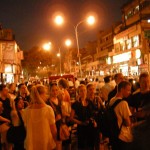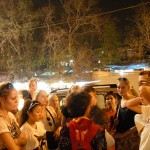January 13, 2012 in Chandni Chowk,Delhi Heritage Walks,DHW,Heritage Walks,Old Delhi | Comments (1)
When we think of old Delhi, there are many cliches about its character. We like our old cities to look a certain way: the chaos, the crowd, the noise, and yet the seeming ease with which every thing operates. Yes, on the surface perhaps all old cities are like that, and our purani dilli is no different. Yet, there is more to these that catches the eye. Cities, even historic ones, change rapidly, and often these changes come and go without us noticing them. This heritage walk to the old city tries to capture a little bit of all of this: the life of the city, what is typical and what lies beneath the typical.
We start our heritage walk just outside the Red Fort. The fort was the palace complex of Shahjahan, and what is today the purani dilli for us, was Shahjahanabad, the capital city of the Mughals in the 17th century. As we step into Chandni Chowk, we are greeted by two monumental temples, the Digamber Jain Lal Mandir in red sandstone and the Gauri Shankar temple in white. There is a small flower market right across the road which caters to the devotees who come in and pray. This entire land was once the estate of Begam Samru. Orignially a dancing girl from Kashmir she went on to marry a European, Walter Reinhard and covnverted to Christianity. She is particularly known for establishing the church at Sardana, near Meerut. Today whatever little of her mansion remains, has become part of Lala Bhagirath market. Continue Reading This Post
December 13, 2011 in Chandni Chowk,Chandni Chowk Heritage Walks,Delhi Heritage Walks,DHW,Heritage Walks,Old Delhi | Comments (0)
It is a truism that the city never sleeps. Yet this restless, constant activity is what always amazes us. This was my first thought as we gathered for a heritage walk in old Delhi this Sunday morning. Old Delhi is known for many things: the grandeur of the Mughals, the street food, the bazaars, its havelis and we hoped to capture a little bit of all of this as we rambled through its streets.
Our walk starts at Digamber Jain Lal Mandir, the oldest Jain temple here, and well known for its charitable bird hospital. Next to it is the Gauri Shankar temple, built by a Maratha nobleman. We walked on the main street of Chandni Chowk till the fountain. This roundabout is surrounded by historical landmarks. Continue Reading This Post
September 16, 2011 in Chandni Chowk,Chandni Chowk Heritage Walks,Delhi Heritage Walks,DHW,Heritage Walks,Old Delhi | Comments (2)
A heritage walk in old Delhi evokes all kinds of response one can think of: nostalgia for lost glory; hunger for authentic food; and wonder at the systematic chaos that is the old city, sometimes combined with a feeling of impending doom! Our heritage trail this Sunday morning walk was a mixture of all of this. We start our walking tour at Digamber Jain Lal Mandir, the one famous for its bird hospital. With Red Fort forming the backdrop, we follow the main street of Chandni Chowk right up to the Sisganj gurudwara. On the way is Gauri Shankar temple, SBI buiding, Dariba Kalan and its famous jalebi shop, Central Baptish Church. The fountain chowk where Sisganj stands has much more to it: it marks the spot where Guru Teg Bahadur’s followers were tortured and killed and there is a museum dedicated to their memory. The chowk also has the Sunehri Masjid where the notorious raider Nadir Shah stood to watch the massacre of citizens of Delhi. The Ghantewala Shahi halwai was originally located at the chowk. We leave the main street at Parathewali Gali and entre the lane famous for its shops selling stuffed fried bread (parathas). Continue Reading This Post
March 16, 2010 in Chandni Chowk,Chandni Chowk Heritage Walks,Delhi Heritage Walks,DHW,Heritage Walks,Old Delhi | Comments (0)
A group of students from Denmark on their first trip to India joined us for a heritage walk in old Delhi on Sunday evening. The old city of Delhi is the capital built by the Mughal emperor Shahjahan, who named the new capital after himself, Shahjahanabad. The Red Fort was his palace-fort complex and Jama Masjid the congregation mosque of the city.
We wandered through the narrow lanes of old Delhi: looking at the haveli facades in Katra Khushal Rai, the Digamber Jain Naya Mandir, Naughara, Parathewali Gali. The havelis and Jain temples in the city have a typical late-Mughal aesthetic style: the arches, the life-like representation of flowers, etc, patronised by Shahjahan and used extensively after him. Naughara is a group of havelis (mansions) which still retain much of their traditional appearance.
Next on the route was the main street of Chandni Chowk, Continue Reading This Post
January 4, 2010 in Chandni Chowk,Delhi Heritage Walks,DHW,Heritage Walks,Old Delhi,Old Delhi Heritage walks | Comments (0)
The advantage of starting early was that the Red Fort complex was not crowded. Otherwise on holidays and in evenings one always sees a huge rush…this is a prime tourist destination after all. One enters from the Lahori gate. The shops in Chhatta Chowk weren’t open yet. There are some beautiful murals in the music gallery (Naubat Khana), unfortunately, they are badly deteriorated. One can see the different layers of paint on the wall done over several years. The Naubat Khana now has the Indian War Memorial Museum. The Diwan i Aam or Hall of public audience was our next stop. It is an extremely elegant sandstone building. This is the place where Shahjahan held court daily. The marble throne canopy with its delicate inlay work is awesome! The riverside pavilions are few of the private palaces of the royal family that still exist. The Mughal buildings we see in Red Fort today are only about 20% of all that existed originally. Continue Reading This Post












